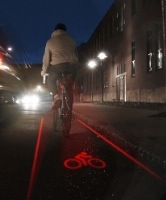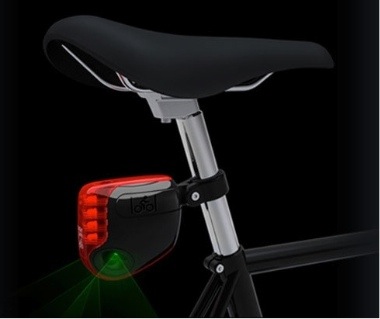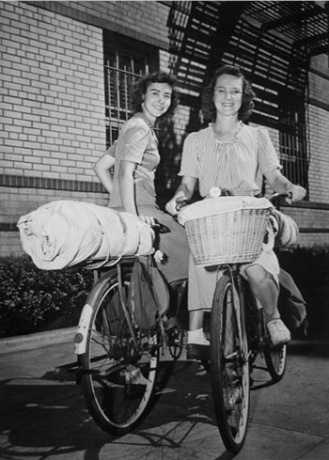- The LightLane
I have literally received a half-a-dozen emails and a couple tweets from Bike Jax readers about the LightLane personal bike path. When it was announced back in January it became an instant darling of the bike blogging community. I chose not to jump on the bandwagon based the original design and information provided at the time. Jack over at Bike Commuters held out posting until he had a chance to talk with the developers at Altitude, Inc. and got all the details.
 The original design photo above showed a very bike lane like image displayed on the ground. I was concerned that the design shown above would possibly put a cyclist at greater risk.
The original design photo above showed a very bike lane like image displayed on the ground. I was concerned that the design shown above would possibly put a cyclist at greater risk.
My first concern was what is know as, the moth effect. Simply put, I was concerned that a driver may be so mesmerized by the shiny little bike lane that they may inadvertently steer into the cyclist.
My second and biggest problem with the product as originally presented was how a driver would react when a bike lane which is normally to the right of the roadway suddenly started to move left as a cyclist prepared for left turn.
 Well it seems that what was just an idea back in January is becoming a reality. The LightLane is currently in the production engineering phase and has released a video of the beta prototype in action. I'll let you guys/gals form your own opinions.
Well it seems that what was just an idea back in January is becoming a reality. The LightLane is currently in the production engineering phase and has released a video of the beta prototype in action. I'll let you guys/gals form your own opinions.
- The Lure of the Open Road.
 It was July of 1944 when Doris Roy and Thelma Popp fresh out of college strapped everything they needed to their single speed and two speed bikes. They were setting out to spend the summer touring the eastern United States. No lycra, no helmets, just styling around on the most basic of bikes. Read about their adventure as they enjoyed The Lure of the Open Road.
It was July of 1944 when Doris Roy and Thelma Popp fresh out of college strapped everything they needed to their single speed and two speed bikes. They were setting out to spend the summer touring the eastern United States. No lycra, no helmets, just styling around on the most basic of bikes. Read about their adventure as they enjoyed The Lure of the Open Road.
- More Fear & Loathing in Bike Safety
Here are couple of Videos that have been making the bike blog rounds.
The first is from the Los Angeles Department of Transportation. It points out the danger that occurs from bike salmons. (Bike Salmon = One who Rides a bike against the flow of traffic)
This next one is from the New York Bike Safety Coalition and is illustrating the importance of paying attention while cycling.
Do these videos make you want get on bike and ride? Do you think they promote cycling as a safe alternative mode of transportation? Or do you think they will scare the bee-jeebus out of anyone just starting out or thinking getting on a bike for the first time?
- Bike Jax In The News
And finally, here is a very nice video about Bike Jax by Julie Watkins at Action News (Ch. 30 &47)

6 comments:
I like the Light Lane for the reason that it can give a real time indication of how far you can stay from parked cars and curbs. I am not sure how visible it would be for a motorist who is not in the passenger seat pointing a video camera at the cyclist! The cyclist in the video was doing many things wrong: riding in the door zone and taking a left hand turn from the right side of the road. Personally, I'd rather get the Down Low Glow.
We need more people like Doris Roy and Thelma Popp promoting the ease and simplicity of bicycles. That not only raises awareness among bicyclists but also among bicycle-hating-motorists.
The LADOT and NY Bike Safety Coalition videos promote the ugly side of any commuting. I would like them to be fair and show videos of charred bodies, smashed skulls and broken bones from car accidents. We will see which crumple zone looks worse then. Bicyclists have half the fatality per million hours than cars do. Bicycles = 0.26 fatalities per million hours, Passenger cars = 0.47 fatalities per million hours(Quoted from Planet Green).
We need not only cyclists but everyone to be prudent in the decisions they take. These videos depict the worst case scenario that no one wants to be in. That is why The Netherlands have separated the two modes of transportation: motor vehicles and bicycles into their separate paths. For a space starved city like NY, they should be learning the most from Amsterdam. They should be promoting a video like this: YouTube Link
Congrats on the air time! Glad to see this important issue get some notice.
The Netherlands seperated traffic by vehicle type for the benefit of motorists, not cyclists. Cycling was already extremely popular in the Netherlands when the automobile arrived on the scene. Rich and influential motorists could not drive faster than cyclists rode because bikes dominated the road. So the motorists pushed cyclists off the road and onto segregated facilities to make motoring more convenient. Immediately the problems with segregating traffic by vehicle type became too much for injured cyclists to bear. So the Dutch installed seperate traffic signals and phases at intersections, doubling red light time, to help counteract the problem. Bike ways were never meant to make cycling safer. They are not designed for this purpose. No scientific study will support the idea that bike ways make cycling safer. In fact, scientific studies (I have liked here before)suggest the opposite is true. Bike ways are meant to make motoring more convenient at the expense of cyclists. Bike ways are at best a waste of resources, and at worst a danger to cyclists. Bicycle activists should not encourage the development of bike ways anywhere.
David,
Thank you for your refute to my comment. You have quoted fair amount of historical facts. I would love to see more evidence so we can use as a template and replicate the same way as the Dutch did forty years ago. The reasons for installing segregated bike paths are quite irrelevant. They may have been constructed to please the Queen of England for all I care. Let’s look at what the misguided Dutch have accomplished to “make motoring more convenient at the expense of cyclists”.
The entire population of The Netherlands makes an average of around 0.85 cycle journeys a day regardless of age, sex, religion, disability etc., rising to 1.4 journeys each per day in Groningen. Even Amsterdam, which befitting its status as the largest city has a relatively "low" cycling rate for this country - though still higher than any city in any other country, now has more cycle journeys than car journeys: something that has been true in other Dutch cities for at least a decade.
Please watch the following video http://www.youtube.com/watch?v=k65RqP-yn-g. It shows a velomobile being ridden 27mph on a separate facility. This shows that a segregated facility does not slow cyclists down. At 1:10 in the video, watch how a truck yields to the velomobile. OMG! LOL!! The ‘rich’ and ‘influential’ motorists have to slow down and yield! Why would they do this to themselves??? How is this system, quoting you again, “a danger to cyclists”?
Here is another video of a cyclist riding along a busy industrial area through traffic lights with priority (You Tube Link). How is this dangerous? How is it a waste of money and resources when it could have possibly saved the lives of Johnny Jones, Eddie Odom, Jack Hartley and Chastity Rettinger. Are you, David, putting a price on human lives and sufferings?
Bike paths are not always constructed to separate the cyclist from an existing roadway. Some times they take an entirely independent path bypassing major roads and busy intersections. For example: the S line bike trail. It is a classic example of an urban trail. We need more of these in different neighborhoods of Jacksonville to get more families less dependent on cars.
If all these mentioned examples, videos and associated logic fail, just consider that a country that has done nothing but increased bicycling trips and safety while reducing accident rates (link), must have gotten something right. The link shows that The Netherlands is the least in fatality rate per 100,000 populations. They can’t be so horribly misleading as John Forrester and his fellow VCers (vehicular cyclists) like to debate.
Bicycling has always been popular in the Netherlands. It is flat and compact, and therefore ideal for trips by bicycle. That has nothing to do with bikeways. The bicycle remains popular in the Netherlands in spite of segregated facilities, not because of them. In fact, bicycling was even more popular there before the introduction of bikeways. The reasons for bikeways are not only relevent, but quite instructive as to their purpose and usefulness. They are purposeful and useful to motorists, not cyclists.
Segregated facilities are a danger to cyclists because they violate the Rules of the Road. Evidence shows that segregated facilities may increase the liklihood of several kinds of accidents, including left hooks, right hooks, and drive-out collisions. These happen to be the most frequently occuring bicycle-automobile collisions. Because segregated facilities remove cyclits from normal traffic patterns, visibility is reduced. This is why the Dutch have seperate phases for bicycles at intersections. They understand that segregated facilities add dangers to the road.
A bikeway has never saved anyone's life. It is a stripe painted on the road that adds confusion, encourages dangerous habits, and collects refuse and debris. I am appalled that you would suggest that I am insensitive to the pain, suffering, and untimely death of fellow bike riders. As a life-long cyclist, I have lost several close friends to accidents. I miss them everyday. I would never dishonor their memory by raising the bloody shirt. Your use of deceased cyclists to promote your political agenda is abhorrent to me.
There is something from the Netherlands that we need in America. It is not road design. Our road design is just fine. It serves all vehicle types safely and efficiently. What the Netherlands has that we do not is bicycle culture. By this I mean that bicycles have long been a part of mainstream life in the Netherlands. Bicyclists are an accepted part of society there. That is not the case here. Road design will not change culture. In fact, bikeways encourage the belief that bicyclists are inferior road users that require special facilities to operate safely. Bikeways reinforce exactly the kind of culture that is harmful to cyclists: the culture of motorist superiority.
I am beginning to understand your point about bike ways. Before I reply, let me define the terms that we are using in our comments so we avoid any miscommunications.
If I understand correctly, there are two different types of bicycle ‘facilities’ in your comment: a bikeway and a segregated bike path. A bike way is what the DOT here refers as a bike lane. It is a glorified paved shoulder with a bicycle stenciled on it. A segregated bike path is either physically separated from the adjacent roadway (with medians or vertical barriers) or stands alone bypassing several roadways (a bike trail)
Having the definitions out of the way, I tend to agree with the dangers of a bikeway or bike lane. I do not have the data to verify if the existence of a bikeway has reduced the number of accidents on a road. I have faced positively less abuses and honks while riding in a bike lane as opposed to on a road with no bike lane. This proves that bike lanes improve subjective safety on a road. The dangers at an intersection still exist, bike lane or not. Motorists are supposed to yield to bicyclists in any situation. That culture needs to be incubated.
The bike lanes I ride on collect debris and provide road hazards. The deaths of Chastity Rettinger happened on a bike lane while that of Jack Hartley happened on a road with no bike lane. It is highly probable that their lives would have been saved on a segregated bike facility with lane priority at traffic lights and intersections.
My agenda is hardly political. It is as human as it gets. It is survivalist. Try riding on Southside Blvd from Baymeadows to the Avenues at rush hour to grasp my motivation. Two colleagues at work regularly attempt this ride. I am worried about my life and the lives of the people who I encourage to start commuting by bicycle.
Quoting you: "Segregated facilities are a danger to cyclists because they violate the Rules of the Road". If the current rules of the road are not efficient, they need to be changed. The Netherlands has nearly a third of the traffic casualties per 100,000 populations than the US does. See study here: link, making Dutch roads three times as safer than US roads. Our road design is not "just fine"! Unless you can provide a statistic that reverses this inference, US Rules of the Road are always going to be inferior.
I agree that the Dutch have separate traffic light phases to reduce the accidents at intersections. The Dutch also impose quite strongly on the motorist to yield to a cyclist. It can be clearly seen in the video with the velomobile posted in my comment above. Is there a reason why this method can not be followed in the US? Clearly, the Dutch have recognized the dangers of a segregated bike path and take appropriate steps to effectively curtail it. The segregated paths also cut through the city when motorists have to drive around. See Examples here: David Hembrow: Directness. I am yet to understand how the motorist triumphs from this.
The Rules of the Road are not the Constitution. They can be changed to reduce accidents. They should be changed to reduce accidents. Moreover, this is not a superiority pageant. Cars have advantages that bicycles do not and vice versa. The objective is to gain a better quality of life, for both cars and bicycles. Bicycling on the road with cars reduces ’Actual Safety’ and ‘Subjective Safety’. If you don’t see it, ask the thousands of people who want to see their kids ride their bikes to school like they used to but don’t.
Post a Comment